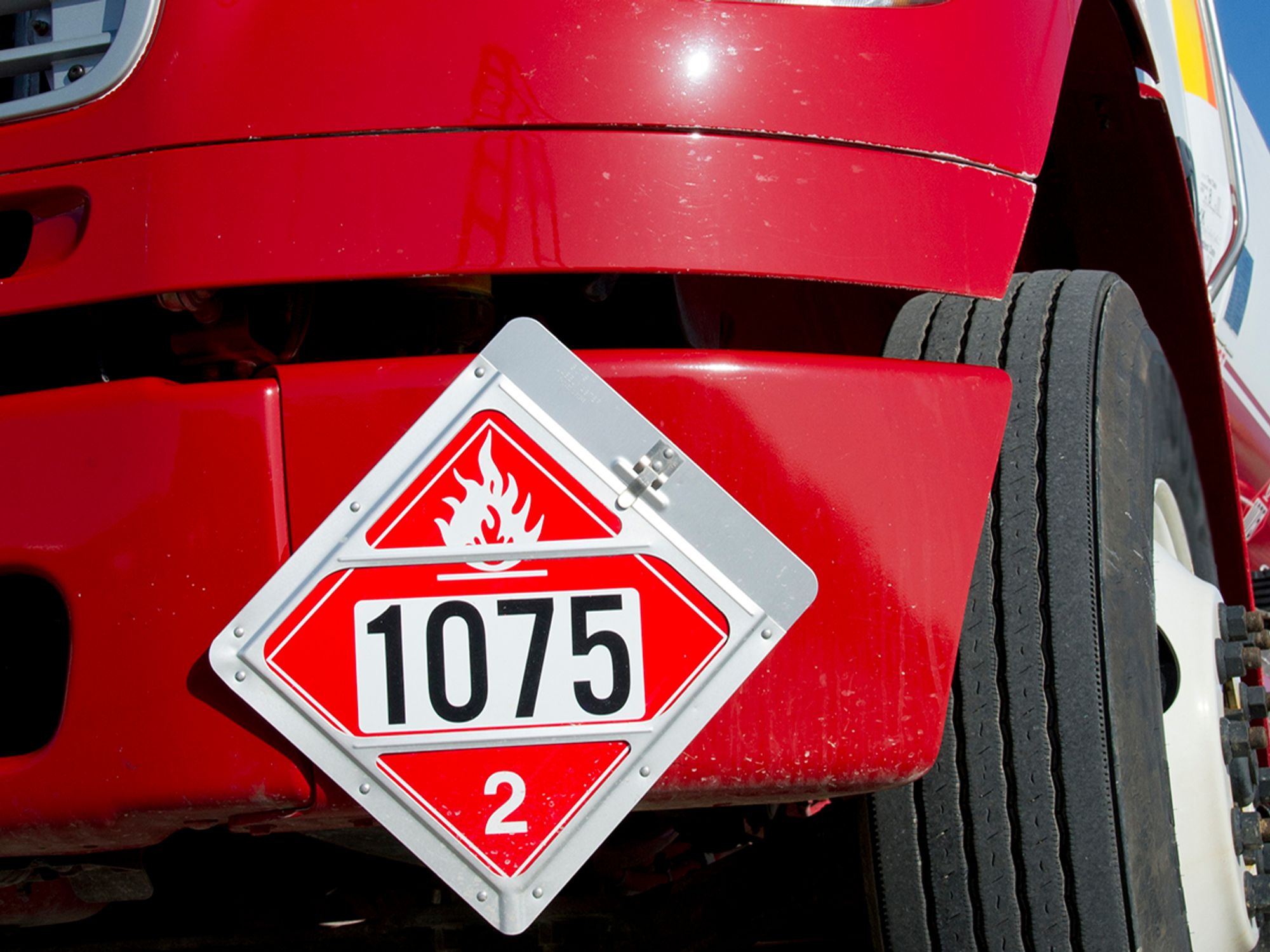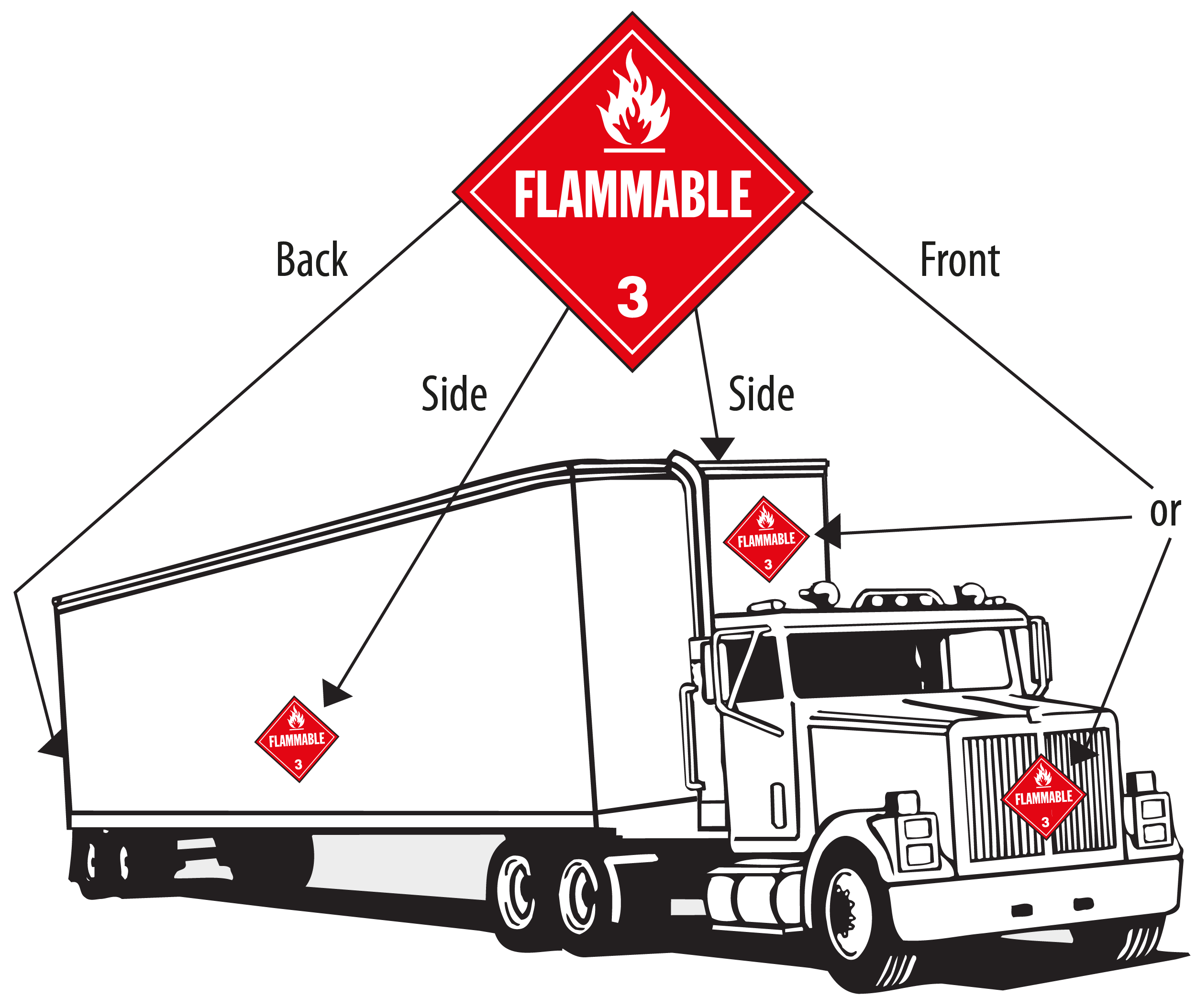Where must placards be displayed?

- An affixed placard must be easily visible from the direction it is facing, unless the vehicle or railcar is coupled to another such unit.
- Bulk packagings, freight containers, and aircraft unit load devices have their own placarding requirements.
Placard placement (172.516)

Each placard affixed to a motor vehicle or railcar must be readily visible from the direction it faces — except from the direction of another vehicle or railcar to which the vehicle or railcar is coupled.
The placard placement for the front of a vehicle may be on the front of the truck-tractor instead of, or in addition to, the placard on the front of the cargo-carrying body (e.g., trailer or semitrailer).
Best practice
Most carriers place the front placard on the front of the tractor to make it easier for the driver to change or remove the placard if necessary.
Placards displayed on freight containers or portable tanks loaded on (not enclosed in) a motor vehicle or railcar may be used to meet placarding requirements for the motor vehicle or railcar.
In addition, each placard on a transport vehicle, bulk packaging, unit load device, or freight container must be:
- Located clear of any appurtenances and devices (e.g., ladders and pipes);
- Located away from any markings — such as advertising — that might substantially reduce its effectiveness, with a minimum distance of 3 inches (76 mm) required;
- Affixed to a background of contrasting color, or must have a dotted or solid line outer border that contrasts with the background color;
- Maintained by the carrier so its effectiveness will not be reduced in any way;
- Placed, as far as practicable, so dirt or water is not directed to it from the wheels of the vehicle;
- Attached, affixed, or placed securely in a placard holder; and
- Displayed with the word(s) or identification number (when authorized) shown horizontally, reading left to right.
Bulk packagings (172.514)
In most situations, a bulk packaging containing hazardous materials that requires placards must be placarded on each side and each end. Each bulk packaging that previously contained a hazardous material requiring placards must remain placarded when emptied unless it:
- Is sufficiently cleaned of residue and purged of vapors to remove any potential hazard,
- Is refilled with a material requiring different placards or no placards (provided that any residue remaining in the packaging is no longer hazardous), or
- Contains the residue of a hazardous substance in Class 9 in a quantity less than the reportable quantity and conforms to 173.29(b)(1).
The following bulk packagings may be placarded on only two opposite sides or may be labeled instead of placarded:
- A portable tank having a capacity of less than 1,000 gallons (3,785 L);
- A DOT 106 or 110 multi-unit tank car tank;
- A bulk packaging other than a portable tank, cargo tank, or tank car (such as a bulk bag or box) with a volumetric capacity of less than 640 cubic feet (18 cubic meters);
- An intermediate bulk container (IBC); and
- A large packaging.
Flexible bulk containers may be placarded in two opposing positions.
Freight containers and aircraft unit load devices (172.512)
A freight container or aircraft unit load device with a capacity less than 640 cubic feet (18 m3) is required to display one placard as specified in Section 172.504. This requirement does not apply if the freight container or unit load device:
- Is labeled according to Subpart E of the Hazardous Materials Regulations (HMR);
- Contains radioactive materials requiring the “RADIOACTIVE YELLOW III” label and is placarded with one “RADIOACTIVE” placard and labeled according to Subpart E; and
- Is identified as prepared according to Part 5, Chapter 2, Section 2.7 of the International Civil Aviation Organization (ICAO) Technical Instructions.
Freight containers with a capacity of less than 640 cubic feet that are not transported by air do not have to be placarded — they may be labeled instead.
